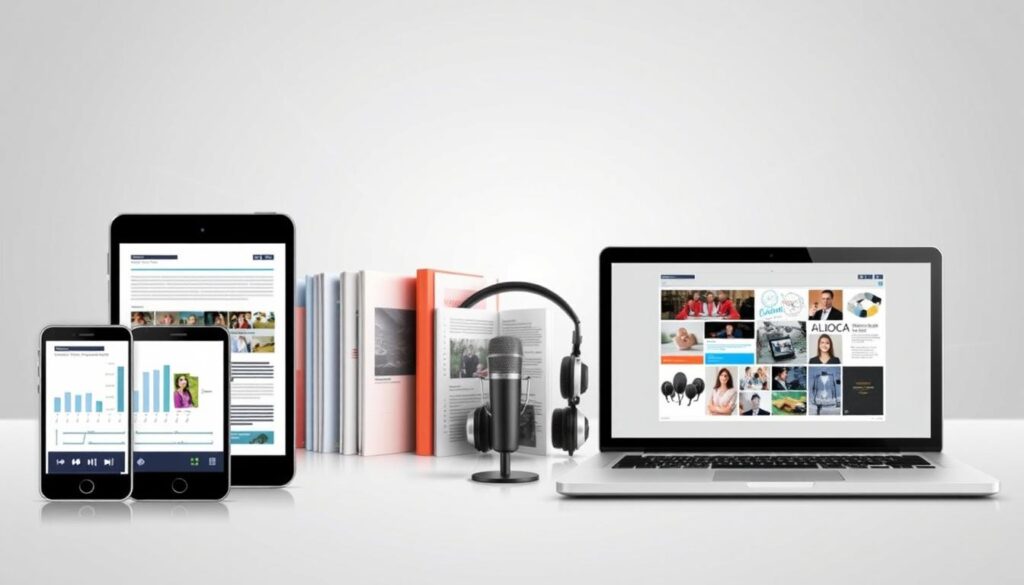In today’s digital age, a new trend is reshaping how businesses connect with their audience: faceless branding. This approach focuses on ideas, aesthetics, and content rather than personal identity. It’s gaining traction, especially with Gen Z, who value inclusivity and creativity over traditional personal branding.
Take HowToBasic, a YouTube channel with over 17 million subscribers. It thrives on absurdist content without ever showing the creator’s face. Similarly, virtual influencers are achieving three times higher engagement than human influencers. These examples prove that anonymity can be a powerful tool in building an online presence.
Faceless branding offers unique benefits like scalability, cultural neutrality, and creative freedom. Unlike traditional methods, it allows businesses to focus on their message rather than the messenger. As we move toward 2025, this approach is set to redefine marketing strategies across social media platforms.
Key Takeaways
- Faceless branding prioritizes ideas and aesthetics over personal identity.
- Virtual influencers achieve 3x higher engagement than human influencers.
- Examples like HowToBasic show the success of anonymity in content creation.
- Gen Z’s preference for inclusivity fuels the growth of faceless branding.
- Key benefits include scalability, cultural neutrality, and creative freedom.
Introduction to Faceless Brands
From early blogs to virtual influencers, anonymity has transformed marketing. In the early 2000s, anonymous blogs allowed creators to share ideas without revealing their identities. Today, this concept has evolved into a global trend, with virtual influencers like Lil Miquela gaining millions of followers on social media.
Platforms like Haute Stock have played a crucial role in this evolution. Their library of stock images and videos helps creators build cohesive visual identities without showing their faces. For example, Roop Creative used Haute Stock assets to design professional video headers, driving higher engagement for their business.
Victoria’s @elysian.living is another standout example. Her bath setup video garnered over 80 million views, proving that anonymity can create a strong online presence. Unlike personal branding, which requires constant face exposure, faceless branding focuses on the content itself.
Hybrid approaches are also gaining popularity. Some creators use strategic face reveals, like profile pictures or About pages, to build trust while maintaining anonymity. This flexibility allows them to connect with their audience without sacrificing their privacy.
One of the biggest advantages of faceless branding is time efficiency. Using stock assets saves creators up to 90% of their time compared to original filming. This makes it an ideal strategy for busy entrepreneurs looking to scale their content production.
| Content Type | Time Investment | Engagement Potential |
|---|---|---|
| Stock Content | 10% | High |
| Original Filming | 90% | High |
As social media continues to evolve, faceless branding offers a unique way to stand out. By focusing on creativity and inclusivity, this approach is reshaping how businesses connect with their audience.
Why Faceless Brands Are Effective
Curiosity and inclusivity are driving the success of nameless marketing strategies. By focusing on ideas rather than identity, these approaches create a unique connection with the audience. This section explores the psychological and cultural factors that make anonymous branding so impactful.
The Curiosity Gap
Anonymity sparks curiosity, a powerful psychological tool in marketing. When creators hide their identity, it leaves room for the audience to fill in the gaps. This curiosity gap increases engagement and keeps viewers coming back for more.
Take Banksy, for example. The anonymous artist’s work sees an 80% increase in demand simply because of the mystery surrounding their identity. This proves that anonymity can elevate the perceived value of content.
Another example is Chillhop Music, which generates $2.4M annually through vibe-based branding. Their consistent audio aesthetics create a sense of familiarity without revealing a face. This approach builds trust and loyalty among listeners.
Bias-Free Relatability
Anonymous strategies eliminate biases, making them more relatable to diverse audiences. A study shows that 72% of Gen Z prefer brands that use inclusive marketing tactics. This demographic values creativity and inclusivity over personal identity.
Virtual influencers like Lil Miquela are a testament to this trend. Despite being artificial, Miquela has earned $12M by connecting with her followers through relatable content. Her success highlights the power of bias-free branding.
Meme culture also plays a role. Community-driven content often garners higher trust than personal posts. Metrics show that faceless infographics are shared 40% more frequently than posts featuring individuals.
| Strategy | Engagement Rate | Key Benefit |
|---|---|---|
| Anonymous Art | 80% Increase | Curiosity-Driven Value |
| Vibe-Based Branding | $2.4M Revenue | Consistent Aesthetics |
| Virtual Influencers | $12M Earnings | Bias-Free Relatability |
These examples demonstrate how anonymity can enhance engagement and build trust. By focusing on the message rather than the messenger, businesses can create a lasting impact on their platforms.
Step 1: Define Your Brand Voice
Building a strong identity starts with crafting a unique voice that resonates with your audience. Your voice is the essence of your message, shaping how people perceive your content. Without a clear tone, your strategy may fall flat, failing to connect with your target audience.
Take the Wait But Why blog, for example. With over 2 million monthly views, it thrives on anonymous storytelling. Its consistent voice combines humor and authority, creating a relatable yet informative tone. This approach keeps readers engaged, proving the power of a well-defined voice.
Tools like Metricool can help maintain consistency. Their analytics track your tone across platforms, ensuring your content aligns with your brand’s identity. Whether you lean toward humor or authority, a clear framework keeps your voice cohesive.
Lofi Girl’s rebranding from ChilledCow is another standout example. Despite the name change, its curated audio identity remained intact. This consistency helped retain its 10 million subscribers, showcasing the importance of a recognizable tone.
To optimize your voice, consider A/B testing different styles. Experiment with text variations to see what resonates most with your audience. Avoid common pitfalls like inconsistent messaging, which can dilute your brand’s impact.
Step 2: Choose the Right Content Formats
Selecting the right content formats is crucial for engaging your audience effectively. Whether it’s through voiceovers, videos, or social media posts, the format you choose can make or break your strategy. Let’s explore some proven techniques and ideas to help you get started.
Voiceover Content Techniques
Voiceovers are a powerful way to deliver your message without showing your face. Start with the right equipment. A quality microphone under $300, like the Blue Yeti, can make a significant difference in audio clarity.
Haute Stock’s templates can also streamline your process. They reduce carousel creation time by 70%, allowing you to focus on crafting compelling narratives. Pair these with Metricool’s scheduling tool, which increases post consistency by 40%, and you’ll have a winning combination.

Faceless Video Ideas
Hand-only tutorials are a great way to create engaging videos. Focus on proper lighting and angles to ensure clarity. For example, a well-lit setup with a neutral background can make your visuals more professional.
Burberry’s AR Snapchat campaign is a standout example. It drove a 23% conversion lift by using faceless augmented reality. This approach proves that creativity can outweigh the need for personal presence.
Instagram Reels are another excellent format. Optimize them by keeping the ideal length between 15-30 seconds and placing text strategically for maximum impact. Stock footage licensing is also worth exploring, as it provides high-quality visuals without the need for original filming.
For animation, compare tools like Vyond and Doodly. Both offer unique features, but Vyond is better for professional-grade animations, while Doodly excels in quick, hand-drawn styles.
Step 3: Leverage Interactive Content
Interactive content is transforming how businesses connect with their audience. By incorporating elements like polls, calculators, and AR filters, you can significantly boost engagement and create memorable experiences. This approach not only keeps users engaged but also encourages them to interact with your platforms more frequently.
Buzzfeed’s quizzes are a prime example of this strategy. With over 15 million monthly shares, their formula can be adapted for niche markets. Whether it’s a personality quiz or a trivia challenge, interactive posts like these drive higher engagement and foster a sense of community.
Tools like Metricool can further enhance your strategy. Their hashtag tracker improves reach by 35%, helping you optimize your social media campaigns. Additionally, Patreon creators leveraging anonymity average $8K monthly, proving that interactive content can be both engaging and profitable.
Gamification techniques, such as badge systems and leaderboards, also play a key role. These elements motivate users to participate actively, creating a sense of achievement. User-generated content (UGC) campaigns, even without face reveals, can build trust and authenticity among your audience.
| Interactive Tool | Engagement Impact | Monetization Potential |
|---|---|---|
| Polls | High | Medium |
| Calculators | Medium | High |
| AR Filters | Very High | High |
Snapchat’s geofilter campaigns are another standout example. These location-based filters not only enhance user experience but also drive local engagement. By integrating these tools into your design, you can create a dynamic and interactive online presence.
Step 4: Build Trust Without a Face
Establishing trust is essential for any business, especially when anonymity is part of the strategy. Without a personal identity, your content and messaging must work harder to connect with your audience. Here’s how you can build credibility while staying anonymous.

Over-Communicate Your Values
Clear communication is key to building trust. Start by defining your core values and consistently sharing them across your platforms. Use tools like Haute Stock’s branded template library to create cohesive visuals that reflect your mission.
For example, @_yes_but built a loyal following by focusing on meme authenticity. Their consistent tone and relatable content resonated with their audience, proving that values matter more than identity.
- Develop a trust-building framework: Consistency > Frequency > Depth.
- Use values communication templates like About pages and FAQs.
- Prepare for crisis management to handle challenges transparently.
Use Transparency Tools
Transparency is crucial for anonymous brands. Tools like ZoomSphere’s trust scoring system can help you audit your media presence and ensure compliance. Blockchain verification is another effective way to prove product authenticity.
Haute Stock’s compliance-ready visual assets are a great resource for maintaining transparency. These tools not only build trust but also streamline your content creation process.
- Leverage audit tools for transparency reporting.
- Explore blockchain verification for authenticity.
- Use compliance-ready assets to maintain credibility.
By focusing on clear communication and transparency, you can build a strong connection with your audience, even without showing your face. This approach ensures your brand remains trustworthy and relatable.
Step 5: Monetize Your Faceless Brand
Monetizing an anonymous online presence requires strategic planning and the right tools. Whether you’re selling digital products or leveraging affiliate marketing, there are proven methods to generate income without revealing your identity. Let’s explore how you can turn your content into a profitable venture.
Sell Digital Products
Digital products are a great way to monetize your content. From eBooks to online courses, these offerings require minimal upfront investment and can scale easily. For example, Canva template sellers earn up to $45K/month by creating reusable designs for their audience.
Start by building a product stack that aligns with your niche. Consider creating NFT collections or downloadable resources like templates and guides. Tools like Metricool’s affiliate dashboard can help track conversions, ensuring your efforts are effective.
Affiliate Marketing Strategies
Affiliate marketing is another powerful way to earn revenue. By promoting relevant products or services, you can earn commissions without creating your own inventory. AI influencers, for instance, earn $10K per post, compared to $3K for human influencers.
To succeed, focus on platforms like the Amazon Influencer Program, which allows anonymous creators to participate. Use Metricool’s performance tracking to monitor your campaigns and optimize for higher conversion rates. Sponsored content rate cards can also help you set competitive pricing for your posts.
By combining these strategies, you can build a sustainable business model that thrives on creativity and anonymity. The key is to stay consistent and leverage the right tools to maximize your earnings.
Challenges of Faceless Branding
Navigating the world of anonymous branding comes with its own set of hurdles. While this approach offers unique benefits, it also requires careful handling to avoid common pitfalls. Two major challenges stand out: building trust and ensuring cultural sensitivity.
Trust Issues
One of the biggest obstacles for anonymous brands is establishing trust. Without a personal identity, audiences may question credibility. Studies show that 43% of faceless startups fail due to poor trust signals. To combat this, focus on clear communication and transparency.
Metrics like bounce rates and conversions can help measure trust. For example, high bounce rates may indicate a lack of connection with your audience. Tools like ZoomSphere’s trust scoring system can audit your media presence and ensure compliance with industry standards.
Anonymous crisis communication protocols are also essential. In case of backlash or misunderstandings, having a plan in place can help mitigate damage and maintain credibility.
Cultural Sensitivity
Global campaigns require careful attention to cultural nuances. Missteps can lead to backlash, as seen in H&M’s meme campaign, which cost the company $130K. To avoid similar issues, create a cultural sensitivity checklist for your content.
ZoomSphere’s cultural audit tools can help identify potential risks. Additionally, community moderation best practices ensure your platforms remain inclusive and respectful. Legal considerations, especially for faceless LLCs, are also crucial to avoid plagiarism risks in stock content usage.
By addressing these challenges head-on, you can build a strong, anonymous identity that resonates with your audience and stands the test of time.
Is Faceless Branding Right for You?
Deciding whether to adopt an anonymous approach depends on your goals and audience. Not every niche or strategy benefits from anonymity. To determine if it’s the right fit, start by analyzing your audiences and evaluating your resources.
Who Are Your Audiences?
Understanding your audiences is crucial. Different demographics respond differently to anonymous content. For example, 78% of faceless travel accounts use Metricool scheduling to maintain consistency. This tool helps creators stay organized while keeping their identity hidden.
Healthline’s face-forward medical content strategy shows that some niches require personal trust. Analyzing your audience’s preferences can help you decide if anonymity aligns with their expectations.
- Use an audience analysis matrix to match demographics with content types.
- Evaluate niche viability to ensure your approach resonates with your target audience.
- Consider hybrid branding for those unsure about full anonymity.
Resource Commitment
Building an anonymous presence requires time and resources. A minimum content budget of $3K/month is often necessary for growth. This includes tools like Metricool for scheduling and competitor benchmarking.
Resource allocation is key. Use a calculator to determine your needs for staff, software, and budget. Proper planning ensures you can maintain consistency across platforms without overextending your resources.
- Explore Metricool’s tools for efficient scheduling and performance tracking.
- Plan for exit strategies if you decide to transition to a personal brand later.
- Invest in tools that streamline content creation, saving you time and effort.
Conclusion
As we look ahead to 2025, the landscape of online presence continues to evolve. Anonymous strategies, like Lofi Girl’s 24/7 live stream, are proving highly profitable, with an average 300% ROI in the first year. This approach allows creators to focus on their content while building a loyal audience.
Looking forward, innovations like VR integration and neural branding will further transform the way we connect on social media. Hybrid models, such as @shopbando’s success story, show that blending anonymity with personal touches can be highly effective. However, complete anonymity extremes should be avoided to maintain trust and credibility.
To get started, explore resources like stock libraries and analytics tools. Haute Stock offers a free trial to help you create cohesive visuals, while Metricool’s faceless branding masterclass provides actionable insights. By leveraging these tools, you can build a scalable and impactful business strategy for the future.

One Comment
Comments are closed.